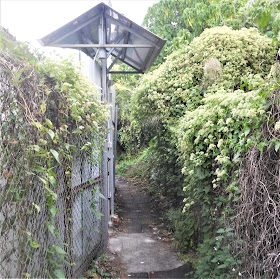When I included a photo of mile-a-minute in Autumn Flowers #4, I received an email from a friend expressing confusion as to what I was referring. I hadn’t been aware that the name ‘mile-a-minute’ referred to more than one species. However, when I googled the term, top of the search list was Persicaria perfoliata, which has become a serious nuisance in the northeastern United States, where it spread from a nursery site in York County, Pennsylvania, in the 1930s. This species, which is also known as ‘Devil’s tail’ and ‘Asiatic tearthumb’, is a native of East Asia, although I’ve never seen any examples here in Hong Kong.
‘Mile-a-minute’ can also refer to Russian vine (Fallopia baldschuanica), which is often sold in the UK as a garden plant. In fact, I bought a small seedling (for 10 pence) in my local supermarket many years ago, but I got rid of it when I saw how it was hell-bent on overwhelming everything else in my garden.
In order to identify what I’d always known simply as ‘mile-a-minute’, I added ‘Hong Kong’ to the search criteria and was directed to the website of the Agriculture, Fisheries and Conservation Department, where I learned that here in Hong Kong, ‘mile-a-minute’ refers to Mikania micrantha. It is a native of the subtropical zones of the Americas and was first recorded in Hong Kong as long ago as 1884. My mistaken statement that it originated somewhere in the Himalayan region was probably based on reading a while ago that it is a serious problem in Nepal, where it has covered 20 percent of one of the country’s national parks. It is now found throughout East, Southeast and South Asia, and on many Pacific islands.
A single stem can produce between 20,000 and 40,000 seeds, which are dispersed aerially and have a high germination rate. It has been recorded as growing at a rate of 8–9cm per day, and it can also grow from small stem fragments, so eradication is extremely difficult. It grows best on abandoned farmland and other forms of disturbed ground, and along roadsides and the edges of woodland, but because it doesn’t like shade, you won’t find it in forested areas.
Anyway, I’ve been taking photos of this pernicious weed for the past week, so here they are, with comments where appropriate.
The first six photos were taken along a 6/7-metre section of a footpath on what was once the floodplain of the Ng Tung River. This area was once extensively cultivated but is now in the process of being ‘developed’. The first photo shows how mikania concentrates its activity on the sunnier (south) side of whatever plant it is using to piggyback upon:
The next four photos show how densely this weed grows. Its leaves are so large that they inhibit—or prevent altogether—photosynthesis by the ‘host’ plant:
The tree with extra-large leaves being climbed over in the next photo is about 6 metres tall but presents no problems to this vicious vine:
The next photo is of mile-a-minute on the banks of the upper reaches of the Sheung Yue River:
We cycle this way regularly, so I plan to take another photo in May next year to see how much it has grown in the meantime.
The next four photos were taken along a little-used path on the south side of the main road to the east out of Fanling (we live to the north, but I consider the south side to also be part of my neighbourhood):
The high-rise block in the background of the third photo is still under construction and is part of what will, eventually, become a huge public housing estate that has already blighted the view from our balcony. I will never again be able to photograph the leaping dragon (bottom of the page) that gives the area its name!
The next four photos were taken along San Tin Tsuen Road, a quiet road carrying very little traffic to the west of Fanling that we cycle along regularly:
I expect the tree in the centre of this photo, currently weed-free, to be engulfed in due course:
…while this photo shows the heights to which this dastardly invader is able to go (the lamp-post is about 7 metres high):
This photo shows how mikania sticks to the sunny side of whatever plant it is climbing up:
I took the next photo along the frontier road, another casualty of recent construction work, in this case a joint science park with Shenzhen. The road was never built to carry eight- and ten-wheeler tipper trucks laden with earth, so it is now pitted with large numbers of potholes:
It shows clearly how mikania is restricted to the edges of wooded areas.
The final photo was taken two days ago during my exploration of the Tam Mei valley, which lies about 20km west of Fanling. It is a general view of the havoc caused by this marauding menace:
The banana plants won’t last much longer.

















No comments:
Post a Comment
Please leave a comment if you have time, even if you disagree with the opinions expressed in this post, although you must expect a robust defence of those opinions if you choose to challenge them. Anonymous comments may not be accepted.